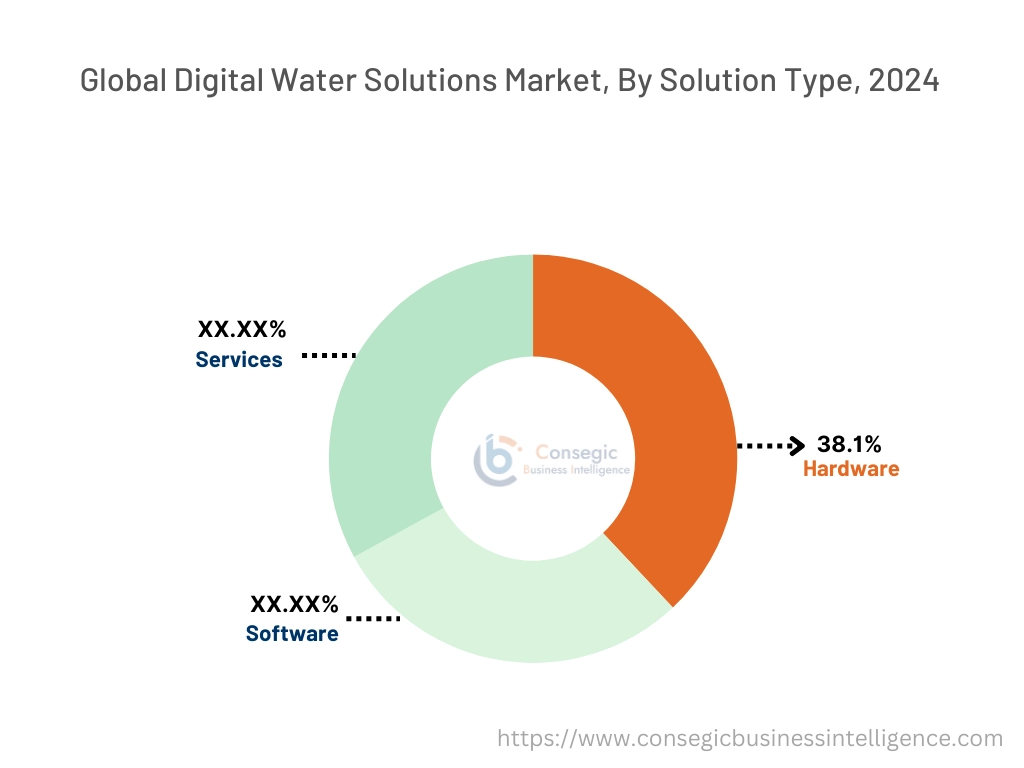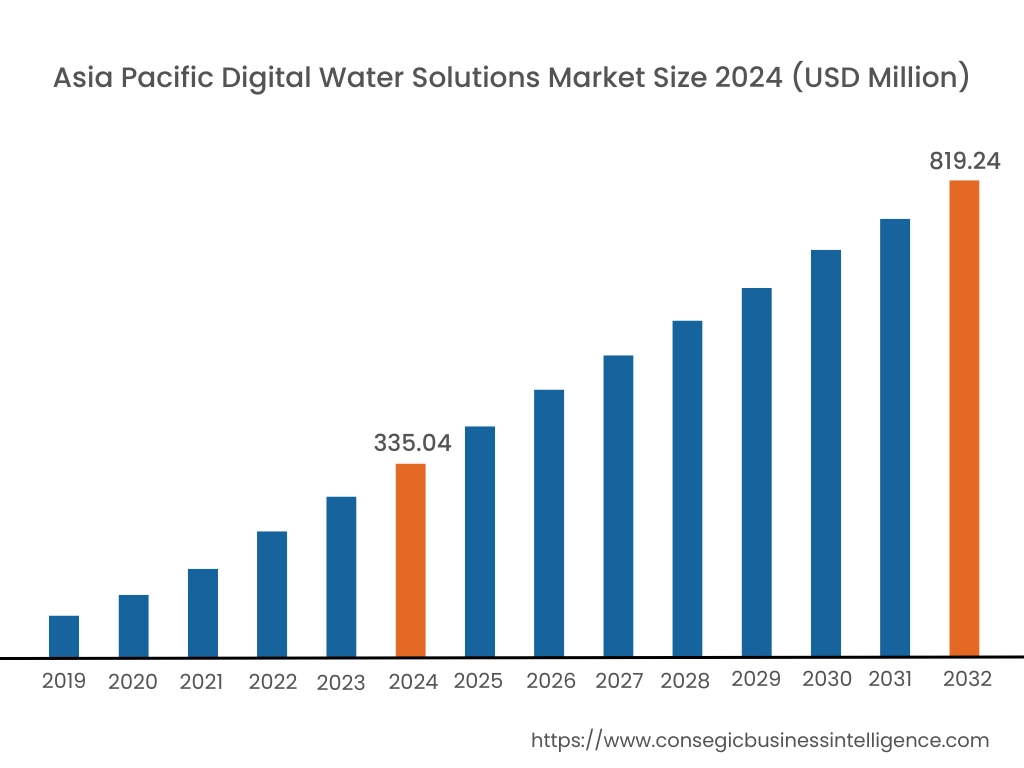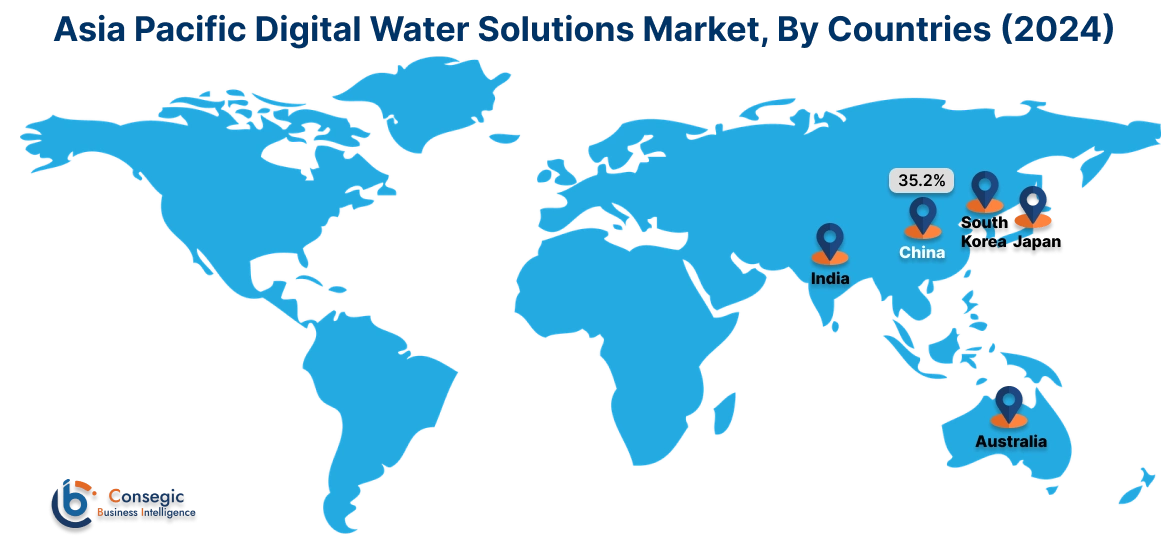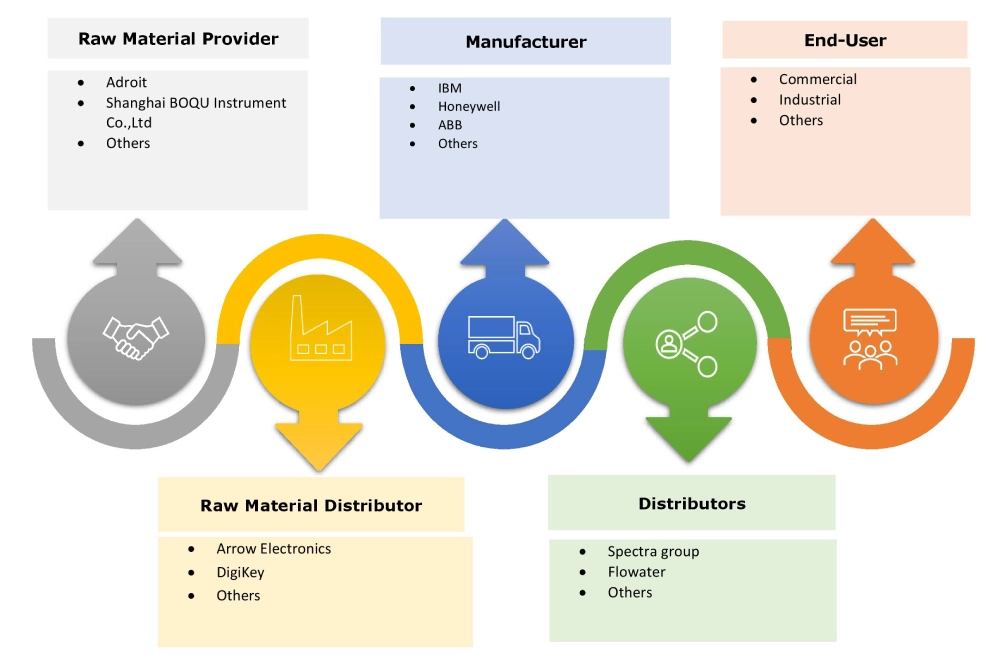Digital Water Solutions Market Size:
Digital Water Solutions Market size is estimated to reach over USD 2,690.43 Million by 2032 from a value of USD 1,137.62 Million in 2024 and is projected to grow by USD 1,246.58 Million in 2025, growing at a CAGR of 11.4% from 2025 to 2032.
Digital Water Solutions Market Scope & Overview:
Digital water solutions leverage advanced digital technologies to improve the management and efficiency of water systems. Additionally, the advantages of solutions including increased efficiency, optimized cost, improved water quality, and predictive analysis among others are driving the market progress. Moreover, the solutions are majorly utilized in municipal, residential, commercial, and other buildings for reducing water wastage and optimal utilization of water in turn, propelling the market evolution. Further, the increase in global water crisis is driving the digital water solutions market demand. Furthermore, the key factors such as climate change, aging infrastructure, environmental changes, as well as growing demand for water are driving the digital water solutions market growth.
Digital Water Solutions Market Dynamics - (DRO) :
Key Drivers:
Digitization of the Water Industry Drives Demand for Digital Water Solutions
The water and wastewater management industries are leveraging technology to enhance efficiency, sustainability, and overall water management which in turn is fueling the digital water solutions market growth. Additionally, the digitalization aims to improve factors such as leak detection, water quality monitoring, and resource allocation among others which in turn is boosting the digital water solutions market demand. Further, digitalization helps in planning, monitoring, and management tasks which in turn is fueling the market progress.
- For instance, in December 2024, Xylem acquired Idrica to accelerate digitalization and tackle critical challenges such as water scarcity and aging infrastructure with real-time insights.
Therefore, digitalization in water and wastewater management in industries is driving the adoption of water management solutions, in turn proliferating the growth of the market.
Key Restraints:
High Infrastructure and Setup Cost is Restraining the Market Growth
The setup of solution requires strategic planning, phased deployments, and leveraging public-private partnerships, which incurs huge infrastructure and setup cost in turn hindering the digital water solutions market expansion. Additionally, the installation cost of sensors, smart meters, and data analytics platforms are expensive restraining the market development. Further, the systems require ongoing maintenance, regular updates, and potential scalability upgrades to remain effective, which in turn restricts the market evolution.
Therefore, the high costs of setup and infrastructure are hindering the digital water solutions market expansion.
Future Opportunities :
Surging Focus Toward Sustainability is Expected to Promote Potential Opportunities for Market Growth
The increasing focus toward sustainability in water management for reducing waste and improving water quality is driving the digital water solutions market opportunities. Additionally, the integration of AI, IoT, and advanced metering infrastructure in solutions for achieving sustainability goals by industries, commercial and residential building among others is propelling the market evolution. Further, the integration of digital twin technologies helps to achieve sustainability in water management is driving the market development.
- For instance, in March 2025, Symetri partnered with Severn Trent Water to achieve sustainability goals as well as achieve carbon neutrality by 2030. Additionally, the Severn Trent Water company invested USD 7.9 billion for providing infrastructure and to ensure the delivery of clean waters.
Hence, the increasing focus toward sustainability is anticipated to increase the utilization of digital solutions in turn promoting prospect for digital water solutions market opportunities during the forecast period.
Digital Water Solutions Market Segmental Analysis :
By Solution Type:
Based on the solution type, the market is segmented into hardware, software, and services.
Hardware segment consists of sensors and IoT devices such as water quality sensors, pressure sensors, level sensors, flow meters, and others. Water quality sensors are used for measuring parameters such as pH, temperature, turbidity, and contaminants. Flow meters are used for monitoring water flow and consumption in real-time to detect leaks or inefficiencies. Level sensors are used for measuring the water level in reservoirs or tanks to manage water supply effectively. Software segment includes platforms that collect, store, and analyze data gathered from various hardware devices to facilitate centralized management of water resources. Additionally, services segment includes consulting services, integration/installation, and maintenance services.
Trends in the Solution Type:
- The rising adoption of hardware for accurate data acquisition and efficient network operation is driving the market progress.
- The rising focus towards centralized water management system is paving the way for adoption of services segment which in turn is fueling the market progress.
Hardware accounted for the largest revenue share of 38.1% in the year 2024.
The hardware component comprises sensors, meter, communication devices and other for precise water quality monitoring and leak detection fueling the market progress. Additionally, the component ensure seamless data transmission for real-time monitoring and control over the distribution network is propelling the market advancement. Further, the rising adoption of hardware by industries, municipalities and others is paving the way for market adoption.
- For instance, in January 2024, Sensata Technologies launched 129CP Series digital water pressure sensor with smart pressure monitoring capabilities to reduce water waste. Additionally, the sensor is designed to improve efficiency and reliability in water metering.
Thus, as per the market analysis, the increased adoption of hardware segment for real-time monitoring and control over the distribution network is driving the hardware segment.
Services is anticipated to register the fastest CAGR during the forecast period.
The rising demand for high-quality water services offering tailored solutions for water management challenges is driving the adoption of services segment. Additionally, the services provide smooth deployment and implementation of solutions with advanced technologies such as IoT and AI. Further, the maintenance service, a crucial service for ensuring long-term operational efficiency with reduced downtime is boosting the adoption of services segment.
Therefore, the rising adoption of maintenance service are anticipated to boost the market during the forecast period.

By Technology:
Based on the technology, the market is segmented into IoT, AI & machine learning, cloud computing, digital twin, and others.
Digital water solutions are increasingly leveraging advanced technologies, such as IoT, AI & machine learning, cloud computing, digital twin, and others, in order to optimize water management and improve decision-making processes. The integration of IoT technology in digital water solution enables real-time data collection, remote monitoring and control, and predictive maintenance capabilities. Similarly, the integration of AI and machine learning offers several benefits including improved anomaly detection, optimized operations, and predictive analytics. Additionally, the utilization of digital twin technology can facilitate real-time monitoring, performance simulation, and asset management among others.
Trends in the Technology:
- The trend towards adoption of IoT-enabled smart meters to provide accurate and real-time data on water consumption is driving the market development.
- The trend towards adoption of advanced AI and ML to detect water leakage and predict pipe bursts in distribution networks is driving the adoption of technology in the market.
IoT accounted for the largest revenue share in the market in 2024.
The rising adoption of smart sensors embedded with IoT technology provides predictive maintenance and anomaly detection which in turn fuels the market progress. Additionally, IoT enabled devices offer real-time monitoring and control of water systems, which in turn reduces risk and enhances decision-making, propelling the market progress.
Thus, as per the market analysis, rising adoption of smart sensor with IoT for real-time monitoring and control is driving the adoption of IoT technology in the market.
Digital Twin is anticipated to register the fastest CAGR during the forecast period.
The rising need for real-time insights, predictive maintenance, and optimized operations is driving the adoption of digital twin technology for efficient and sustainable water resources management. Additionally, the technology has the ability to support decision-making for water utilities which in turn is fueling the market evolution. Further, the rising adoption of advanced technology for improving sustainability and reducing operational costs is boosting the market development.
- For instance, in April 2025, Air Selangor partnered with Schneider Electric for the launch of Digital Twin WTP at Semenyih 2 WTP. The launch aims to provide proactive forecast, real-time monitoring, and optimization, reduce inefficiencies, and improve service quality, among others.
Therefore, as per the market analysis, the rising need for real-time insights, predictive maintenance, and optimized operations are anticipated to boost the market during the forecast period.
By Application:
Based on the application, the market is segmented into water quality monitoring, leak detection, pressure management, and others.
Digital water solution plays a vital role in improving the management of water resources, particularly in applications involving water quality monitoring, leak detection, and pressure management. Moreover, the implementation of digital water solution in water quality monitoring, leak detection, and pressure management applications significantly improves the operational efficiency and effectiveness of water utilities. It also helps in optimizing resource usage while ensuring the safety and reliability of water supplies.
Trends in the Application:
- The trend towards ensuring safe and sustainable water management practices is driving the market adoption for water quality monitoring applications.
- The trend towards adoption of smart water sensors for providing real time monitoring of water leakage is driving the market progress.
Water Quality Monitoring accounted for the largest revenue share in the year 2024.
The rising adoption of monitoring solutions enabled with compliance and regulatory standards for real-time detection of contaminants is driving the water quality monitoring segment progress. Additionally, industrial, commercial, and residential end users prioritize water quality for safeguarding public health and operational efficiency in turn propelling the market development.
- For instance, in August 2024, HazEL partnered with AquaWatch to accelerate improvement in continuous water quality monitoring and chemical risk management by leveraging HazEL framework and AquaWatch advanced sensors.
Thus, as per the market analysis, rising adoption for real-time detection of contaminants is driving the market adoption for water quality monitoring applications.
Leak Detection is anticipated to register the fastest CAGR during the forecast period.
The rising adoption of leak detection for minimizing water losses and operational disruptions is fueling the market progress. Additionally, the increasing focus towards water conservation and sustainability promoted by various governments is driving the market progress. Further, the integration of AI and IoT for predictive analytics to enhance accuracy and efficiency in leak detection is driving the digital water solutions industry.
Therefore, as per the market analysis, the integration of AI and IoT for predictive analytics are anticipated to boost the market during the forecast period.
By End-User Industry:
Based on the end user, the market is segmented into municipal, industrial, residential, and commercial.
Digital water solutions are primarily used in municipal, industrial, residential, and commercial sectors for optimizing water management, enhancing efficiency, and ensuring sustainability. These solutions offer several features including real-time water consumption tracking, leak detection and management, water quality monitoring, water usage optimization, and others. The above characteristics of digital water solution are further driving its adoption in municipal, industrial, residential, and commercial sectors.
Trends in the End User:
- The rising focus on cost reduction and sustainability in industrial water management is driving the digital water solutions market trends.
- The increasing adoption of IoT and AI technologies by municipalities, residential and commercial building is fueling the digital water solutions market trends.
Municipal accounted for the largest revenue share in the year 2024.
The rising adoption of smart water meters by municipality to improve efficiency, reduce costs, and ensure sustainable resource management is fueling the digital water solutions market share. Additionally, the growing need for improved water infrastructure and management solutions is driving the market adoption by municipalities. Further, municipal water networks leverage smart water solutions for leak detection, quality monitoring, and pressure management drives the digital water solutions market size.
Thus, according to the digital water solutions market analysis, growing need for improved water infrastructure and management solutions is driving the market adoption by municipals.
Industrial is anticipated to register the fastest CAGR during the forecast period.
The integration of digital twin technology in industries to enhance efficiency as well as enable monitoring and control over the operations fuels the digital water solutions market size. Further, the increasing focus towards process optimization, wastewater treatment, and resource conservation by industries is fueling the digital water solutions market share. Moreover, the changing government rules and regulations in the field of wastewater management are driving the adoption of smart water solutions.
Therefore, according to the digital water solutions market analysis, the integration of digital twin technology in industries is anticipated to boost the market during the forecast period.
Regional Analysis:
The regions covered are North America, Europe, Asia Pacific, Middle East and Africa, and Latin America.

Asia Pacific region was valued at USD 335.04 Million in 2024. Moreover, it is projected to grow by USD 368.17 Million in 2025 and reach over USD 819.24 Million by 2032. Out of this, China accounted for the maximum revenue share of 35.2%. The market is mainly driven by rapid urbanization and industrialization. Furthermore, factors including rising adoption of smart metering systems as well as smart city initiative by government are projected to drive the market growth in Asia Pacific region during the forecast period.
- For instance, in January 2025, according to PIB, Government of India launched Swachh Sujal Gaon' initiative for creating awareness towards Water Hygiene and Conservation by leveraging real-time information on Village-level Water Supply Status.

North America is estimated to reach over USD 871.97 Million by 2032 from a value of USD 377.36 Million in 2024 and is projected to grow by USD 412.71 Million in 2025. The North American region is leveraging the capabilities of real-time monitoring systems as well as implementing advanced metering infrastructure, which in turn is offering lucrative growth prospects for the market. Additionally, the rising adoption of smart technologies for water conservation is driving the market progress.
- For instance, in May 2021, Ecolab Inc. launched water flow intelligence, which is a digital solution for enterprise to provide real-time visibility of water usage with asset levels, which in turn is fueling the digital water solutions industry.
The regional evaluation depicts that the strong emphasis on sustainability as well as stringent environmental regulations is driving the market in Europe. Additionally, the key factors driving the market are water scarcity issues as well as adoption of digital water technologies is propelling the market adoption in the Middle East and African region. Further, the modernization of water solutions as well as smart city initiative is paving the way for the progress of market in Latin America region.
Top Key Players and Market Share Insights:
The global digital water solutions market is highly competitive with major players providing digital water solutions to the national and international markets. Key players are adopting several strategies in research and development (R&D), product innovation, and end user launches to hold a strong position in the digital water solutions industry. Key players in the global digital water solutions market include-
- Siemens AG (Germany)
- Schneider Electric (France)
- ABB Ltd. (Switzerland)
- IBM Corporation (USA)
- Bentley Systems, Inc. (USA)
- Xylem Inc. (USA)
- SUEZ Group (France)
- Emerson Electric Co. (USA)
- Honeywell International Inc. (USA)
- General Electric Company (GE) (USA)
Recent Industry Developments:
Product Launches:
- In September 2024, DuPont launched Digital Tool which leverages various water treatment technologies which in turn is utilized to help users estimate key sustainability indicators.
Mergers & Acquisitions:
- In November 2024, Ecolab acquired Barclay for catering to the customer across North America to improve water safety as well as reduce water and energy usage by integrating ECOLAB3D with Barclay’s water safety solutions.
Digital Water Solutions Market Report Insights :
| Report Attributes | Report Details |
| Study Timeline | 2019-2032 |
| Market Size in 2032 | USD 2,690.43 Million |
| CAGR (2025-2032) | 11.4% |
| By Solution Type |
|
| By Technology |
|
| By Application |
|
| By End-User Industry |
|
| By Region |
|
| Key Players |
|
| North America | U.S. Canada Mexico |
| Europe | U.K. Germany France Spain Italy Russia Benelux Rest of Europe |
| APAC | China South Korea Japan India Australia ASEAN Rest of Asia-Pacific |
| Middle East and Africa | GCC Turkey South Africa Rest of MEA |
| LATAM | Brazil Argentina Chile Rest of LATAM |
| Report Coverage |
|
Key Questions Answered in the Report
What is the size of the Digital Water Solutions Market? +
The Digital Water Solutions Market size is estimated to reach over USD 2,690.43 Million by 2032 from a value of USD 1,137.62 Million in 2024 and is projected to grow by USD 1,246.58 Million in 2025, growing at a CAGR of 11.4% from 2025 to 2032.
What are the key segments in the Digital Water Solutions Market? +
The Digital Water Solutions market is segmented by solution type (hardware, software, services), technology (IoT, AI & machine learning, cloud computing, digital twin, others), application (water quality monitoring, leak detection, pressure management, others), end-user industry (municipal, industrial, residential, commercial), and region (Asia-Pacific, Europe, North America, Latin America, Middle East & Africa).
Which segment is expected to grow the fastest in the Digital Water Solutions Market? +
The services segment is expected to register the fastest CAGR during the forecast period. This growth is driven by the increasing demand for consulting, integration, and maintenance services to deploy and manage complex water management technologies, particularly as utilities and industries seek efficiency and sustainability in their water systems.
Who are the major players in the Digital Water Solutions Market? +
Key players in the Digital Water Solutions market include Siemens AG (Germany), Schneider Electric (France), ABB Ltd. (Switzerland), Xylem Inc. (USA), SUEZ Group (France), Emerson Electric Co. (USA), General Electric Company (GE) (USA), IBM Corporation (USA), Bentley Systems, Inc. (USA), and Honeywell International Inc. (USA).


